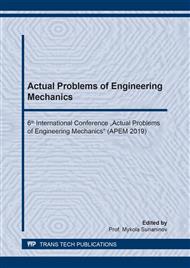p.475
p.486
p.496
p.511
p.519
p.528
p.534
p.541
p.548
Stressed State of the Axisymmetric Adhesive Joint of Two Cylindrical Shells under Axial Tension
Abstract:
The research of the deflected mode of the construction, composed of two coaxially-glued cylindrical pipes, is done. Pipes are considered as thin-walled axisymmetric shells, which are joined by adhesive layer of a certain thickness. The shearing stresses in the glue are considered to be constant over the thickness of the adhesive layer, and normal stresses are linearly dependent on the radial coordinate. The shearing stresses in the adhesive layer are considered to be proportional to the difference in the longitudinal displacements of the shell sides that are faced to the adhesive layer. Normal stresses are proportional to the difference in radial displacement of the shells. It is supposed that the change in the adhesive layer thickness under deformation does not affect the stress, that is, the linear model is considered. The problem of the joint deflected mode finding is reduced to the system of four ordinary differential equations relative to the radial and longitudinal displacements of the layers. The system is solved by the matrix method. Displacements of layers outside of the adherent area can be found by the classical theory of axisymmetric shells. Satisfaction of boundary conditions and conjugation conditions leads to a system of twenty two linear equations with twenty two unknown coefficients. The model problem is solved; the results are compared with the computation made by the finite element method. The tangential and normal stresses in the glue reach the maximum values at the edges of the adhesive line. It is shown that the proposed model describes the stressed state of the joint with high accuracy, and this joint has an influx of glue residues at the ends of the adhesive line but can not be applied in the absence of adhesive influxes. Because in this case, the tangential stresses due to the parity rule reach maximum values not on the edge, but at some distance from the edge of the line. As a result, the distribution of normal stresses at the edge of the line also substantially changes. Thus, the proposed model with certain restrictions has sufficient accuracy for engineering problems and can be used to solve design problems.
Info:
Periodical:
Pages:
519-527
Citation:
Online since:
August 2019
Authors:
Price:
Сopyright:
© 2019 Trans Tech Publications Ltd. All Rights Reserved
Share:
Citation:


